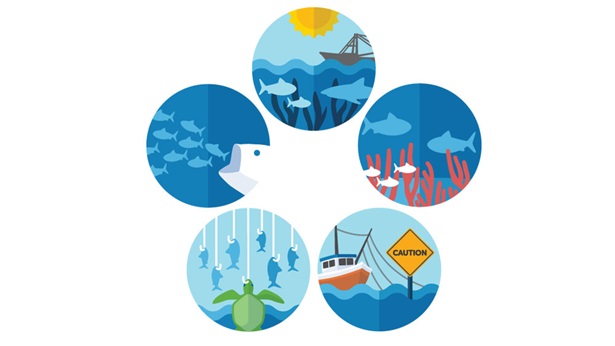Fishery Ecosystem Plans
Big-picture thinking for healthy ecosystems and coastal communities
This brief was updated on June 17, 2015 to reflect message refinements.
Our fisheries management system emphasizes the health of individual fish populations or stocks. This singlespecies approach does not fully account for the interconnections of marine life, the ever-changing environment, and the impact of human activities, including commercial, recreational, and subsistence fishing. To address the challenges of a changing climate, expanding use of the ocean, and coastal development, fishery management needs a broader focus.
A fishery ecosystem plan (FEP) is a road map for a comprehensive management system that includes the latest science on the important connections among predators, prey, habitat, and human activities. An FEP can help regional fishery management councils assess an ecosystem to identify its interacting parts, including the role of fishing; determine crucial indicators of its overall environmental and economic health; and set goals for protecting and enhancing its functions. This information can improve the management of individual species by allowing managers to better identify risks to populations and fisheries and to take appropriate action to protect the health of ecosystems and local economies.
Some regional councils have already begun using FEPs to transition from a single-species approach to a more comprehensive one. Taking further steps at the regional level toward this style of fisheries management is crucial for confronting the 21st-century problems facing the ocean and for protecting fish and fishing for future generations.
The solution
As part of the reauthorization of the Magnuson-Stevens Act, Congress should promote more comprehensive management by requiring regional councils to:
- Develop FEPs for all ecosystems under their jurisdiction. These plans should be based on existing scientific data and should include, at a minimum and to the extent information is available, a description of the ecosystem and the human and other interactions that affect it, a list of indicators that track its environmental and economic health, and measurable goals and objectives for restoring and maintaining it.
- Implement FEP conservation and management measures through fishery management plans. FEPs complement existing fishery management plans by enhancing single-species management with information and guidance on the ecosystem health trade-offs that could result from various management measures.
Fishery ecosystem plans: A closer look
Councils would not have to start from scratch when creating FEPs. Scientific information, tools, and resources are already available to facilitate the development of these plans and help councils transition to a more comprehensive approach to fisheries management.
A few councils have already started developing fishery ecosystem plans. The Pacific Fishery Management Council, for example, adopted an FEP for much of the West Coast in 2013; its first ecosystem management action, to be taken through existing management plans, would prohibit the development of new fishing on forage species, such as sand lance and saury, until the effect on food webs can be evaluated.1 The North Pacific Fishery Management Council created an FEP for the Aleutian Islands and is moving to create one for the Bering Sea that seeks to preserve the health of both the ecosystem and the communities that depend on it.2
There is much to be gained by undertaking a fishery ecosystem plan. Agreeing on and communicating broader ecosystem-management goals and objectives can add value to a council’s public decision-making process. Monitoring ecosystem indicators can help a council better forecast trends and identify future research and data needs. An FEP also can provide a transparent framework for analyzing and understanding the ecological, social, and economic trade-offs of potential management actions, improving management effectiveness and reducing uncertainty for businesses and communities that depend on the ecosystem for their livelihoods.
Endnotes
- Pacific Fishery Management Council, Comprehensive Ecosystem-Based Amendment 1: Protecting Unfished and Unmanaged Forage Fish Species of the U.S. Portion of the California Current Ecosystem, Draft Environmental Assessment (August 2014), http://www.pcouncil.org/wp-content/uploads/H1a_Att1_EWG_Initiative_One_SEPT2014BB.pdf.
- North Pacific Fishery Management Council, Aleutian Islands Fishery Ecosystem Plan (December 2007), http://www.npfmc.org/wpcontent/PDFdocuments/conservation_issues/AIFEP/AIFEP12_07.pdf; and Diana Evans, “Bering Sea Ecosystem Plan Discussion Paper,” North Pacific Fishery Management Council (January 2014), https://npfmc.legistar.com/View.ashx?M=F&ID=2898637&GUID=D9948979-119D-4DAA-9321-8B081A5303FD.




